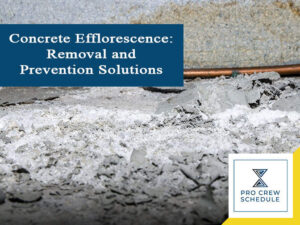One of the most challenging issues every concrete contractor has faced is efflorescence because of how difficult it is to fix. Concrete can be vulnerable to stains, especially when materials like salt will come off directly to the concrete surface. The stains are more present in darker colors due to the contrast being created by the chemical reactions. Efflorescence is usually triggered by condensation, lower temperatures, rain and humidity. It can generally happen also when water is added to concrete for manageability purposes.
Let’s begin understanding what concrete efflorescence is all about, including the major causes why it occurs, the preventative methods and other practical solutions to fix it.
What is Efflorescence and What Causes It?
Efflorescence is described as a typical appearance of a powdery and unwanted substance usually found on mortar or concrete surfaces. This off-white discoloration to masonry and concrete forms usually comes to the concrete surface by capillary voids. This will be the major result of gradual temperature changes, condensation, moist migration, and too much water during concrete mixing. Concrete contractors have to take note of efflorescence because it happens too quickly and over time. Also, a subcontractor scheduling software is one of many vital things they need to take note of and apply in the midst of the work.
Materials that contain Portland cement are commonly susceptible to efflorescence. It typically occurs when lime is formed during cement hydration reaction. Additionally, lime is also formed when the water is transported to the surface by the concrete capillaries. However, efflorescence can also be caused by sulfates and hydroxides are proven to be more soluble in water compared to calcium.
Therefore, these forming salts often come from aggregates, water, admixtures and cement. The result in either of these cases is an off-white discoloration. Other factors that cause the off-white effects of efflorescence are listed below:
· The inappropriate rising of masonry right after repointing
· Mortar joints are believed to be deficient.
· Water migration into the wall surface causing evaporation
· Salts are impregnated directly on the concrete surface.
· Other issues such as inappropriate expansion joints, flashing and caulking
· If the water concrete during the concrete mixing is more, the concrete becomes porous.
· During rainy seasons, the surplus water acted as a medium for salts; thus, it forms a white powder.
· The slow rate of water evaporation allows time for salts to infuse in the wall surface.
· Variability of concrete curing can significantly result in localized issues wherein water infuses more easily.
· When the concrete is not properly cured, the hydration process can be incomplete.
· Any un-hydrated products close to the surface can form efflorescence.
The Preventative Method of Concrete Efflorescence
Below are some of the most preventative methods used in avoiding efflorescence in the concrete.
1. Installation of a vapor barrier is necessary to avoid moisture movement from the subgrades to the slab surface. With the use of task scheduler software, installations like this are easier to manage, track and monitor.
2. Inclusion of metakaolin or Class-F fly ash can enclose a considerable amount of calcium hydroxide in the concrete.
3. The use of waterproofing agents is a must-do to lessen the permeability of concrete.
4. Application of coatings and sealers can thwart surface water from penetrating the slabs.
5. Hardened concrete should be prevented from direct exposure by maintaining the site drainage and surface sealers.
6. Preventing hardened concrete can also be done from rising groundwater through proper plastic membranes under slabs.
7. Ensure that concrete becomes denser to reduce the porousness of concrete to a much greater extent.
8. The utilization of selected concrete ingredients like cement, sand, and aggregates contain fewer salts.
9. The consolidation of grouts with mechanical vibration is proven to limit the chances of voids.
10. The masonry should be kept off the ground and cover it with waterproof materials.
11. Pay extra attention to sprinklers ensures the prevention of water from reaching building materials.
12. Implementation of overhanging copings, flashings, and eaves will reduce water risk from penetrating to walls.
13. Remove soil and sweep all debris from the surface.
14. Dilute the products using a plastic container and follow a 1:4 dilution.
15. Spray or brush any diluted materials on the surfaces carefully.
16. Allow the used materials to work for at least 1 minute.
17. If the efflorescence is too heavy, use a bristled nylon brush and start scrubbing.
18. A more concentrated dilution is proven to be more usable in the process.
Removing Effloresce in Concrete Using 3 Ways
Before removing concrete efflorescence, contractors must first determine the primary sources and causes of efflorescence and why it occurs. Mitigating the speculations is necessary, as well as deploying a crew schedule software for project and crew management purposes. Furthermore, the removal of efflorescence in the concrete can be done in 3 ways.
1. Pressurized Water
The use of a pressurized water jet is one of the most common ways to remove concrete efflorescence. Applying pressurized water might quickly dissolve efflorescence. However, preparing the process is necessary because the water can promptly dry off after removing the efflorescence. If not dried, the same water causes the efflorescence to reappear again.
The preparation of this process can be tricky, especially if not managed properly. Using construction scheduling software, concrete contractors can properly assess everything, including materials used and the crew involved.
2. Brushing
Other types of efflorescence can be easily removed using a brush o broom. Concrete contractors usually apply this method because it is way easier. However, if the results are not too good, scrubbing with the use of clean water is another option. Make sure to rinse it lightly on the surface area.
With the use of builder trends software, the implementation of this method is more manageable. It will be easier and extra convenient for the contractors to monitor every phase. All tasks are appropriately scheduled and all participating crew can be correctly designated in their individual tasks.
3. Dilute Acid Solution
The application of concentrated acid is never recommended on concrete. However, there are times when it can only be the most practical solution to remove efflorescence. If that is the case, make sure there is a diluted proportion of 1:20 used in concentrated acid. Additionally, the surface wherein the acid is applied should be moist enough without the presence of water.
The applied solution can be expected to react on the surface of the concrete for about 10-15 mins. Next, the concrete surface must be rinsed thoroughly and should be scrubbed using clean water. Projects manager for concrete projects can choose to repeat the rinsing process at least twice until every trace of the acid solution is finally removed.
Below are some of the most common acids used in removing concrete efflorescence:
· Phosphoric acid
· Hydrochloric acid
· Prepackaged efflorescence removers
Furthermore, other available commercial products are considered as alternative options in removing the concrete efflorescence. Nevertheless, contractors always need to be sure that all appearing joints and cracks are already adequately sealed. When using such products, apply it first to small areas in order to determine if it works out or deteriorates the concrete.
Coating Application in Preventing Concrete Efflorescence
Among other ways to fix the issues of efflorescence, a coating application has become the most recommended. The coating is believed to absorb much more water across the wall and masonry surface. If that is the case, it will stop efflorescence from recurring. Additionally, the combination of white wine vinegar and warm water is proven to eliminate concrete efflorescence.
Sealant coat is the most common type of coat used for fixing efflorescence. The application of this coat can be done in 3 easy steps:
1. Rinsing of concrete
Make sure to rinse the surface first with water. If the surface area is outdoors, using a hose is more convenient to spray down the surface. If the surface area is indoors, using a spray bottle filled with clean water is a great option for carefully rinsing the surface.
2. Applying the Solution
Use a cleaning solution and spray it all over in the surface area, allowing it to sit for a couple of minutes. Concrete contractors are given an option to apply multiple coats to the surface only if necessary. By doing so, it results in many optimal results.
3. Rinsing of concrete again
Rinse the surface area using water for one last time. Next, use new and dry cloth to clean the surface. Make sure the surface area is very dry in order to reduce the risk of recurring efflorescence. Furthermore, applying coatings roughly 1//4 inches below the surface is also a huge help. It will prevent water from fading and passing through the treated areas as soluble salts and vapor.
Key Takeaways
Today, cleaning efflorescence from concrete surfaces is still an ongoing solution and has become a treatment rather than finding a cure. Sealing the surface has become the most common solution. However, if water still finds many ways to penetrate the surface, contractors have to end up considering spalling or cracking – a destructive yet very useful process.







